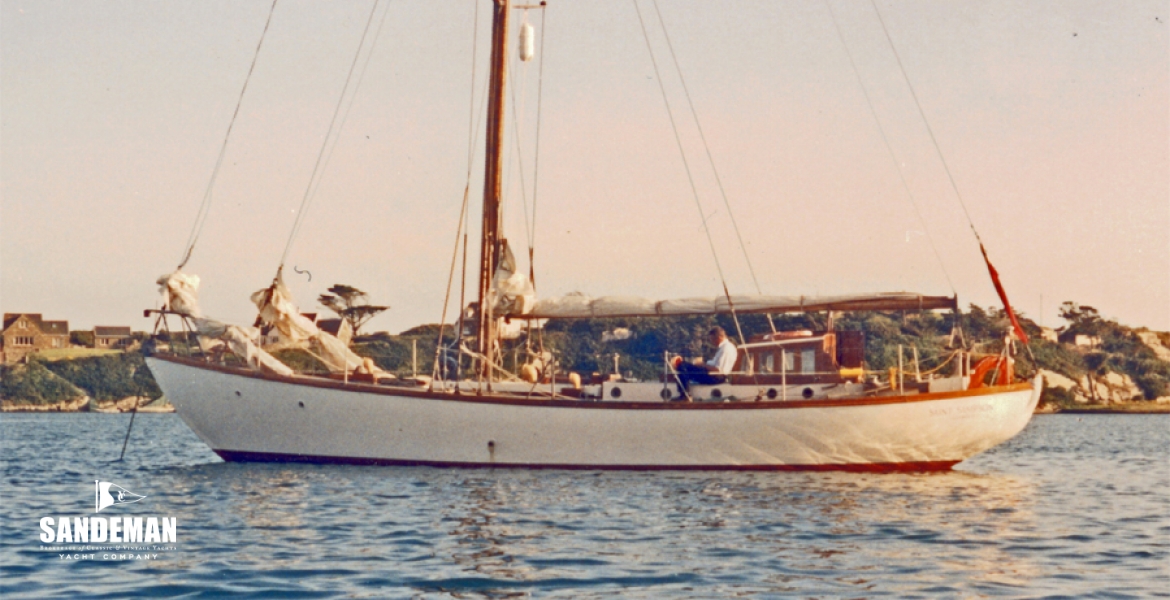
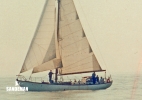
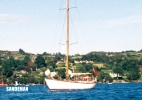
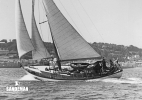
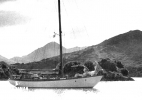


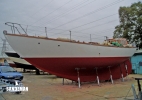
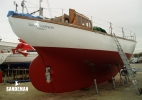
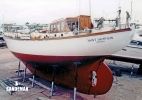
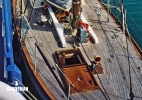

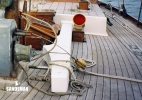
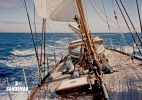

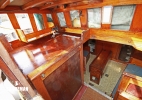
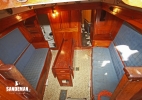
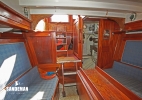

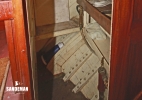
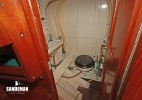
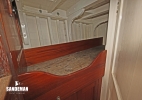
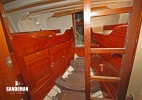
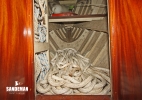
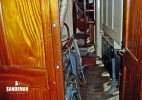
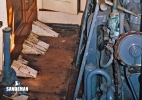
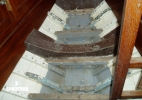
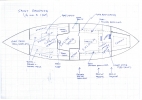
| Designer | E A Dorey |
|---|---|
| Builder | E A Dorey, Guernsey |
| Date | 1954 |
| Length overall | 44 ft 11 in / 13.7 m |
| Length deck | 44 ft 11 in / 13.7 m |
| Length waterline | 35 ft 1 in / 10.7 m |
|---|---|
| Beam | 12 ft 2 in / 3.7 m |
| Draft | 6 ft 7 in / 2 m |
| Displacement | 15.9 Tonnes |
| Construction | Pitch pine planking on oak frames |
| Engine | Gardner 4 LW |
|---|---|
| Location | United Kingdom |
| Price | Sold |
These details are provisional and may be amended
A robust cruising boat, stoutly built of first class materials, SAINT SAMPSON carries her lines beautifully. Gear and domestic fittings, designed originally with a view to simplicity, have remained essentially unchanged, and a new owner might take the opportunity to modernise the equipment. Judiciously done however such enhancement need in no way detract from the distinctive character of this fine yacht. Overall she is a stalwart little ship - and pleasing to a sailor\'s eye.
Interested in SAINT SAMPSON in more detail.
- Stainless steel wire guard rails, the ends of each wire section (i.e. at bow and stern and at each end of a clear away section amidships) attached to galvanised steel stanchions or pulpit, with alloy stanchions between
- Teak toe rail
- Stainless steel jackstays, rigged on each side from the doghouse to the pulpit, for attachment of safety harnesses
- Dan-buoy and floating emergency light
- Firdell radar reflector
- Distress calls: VHF (see above) but the vessel being out of commission there are currently no in-date fireworks
- Fire extinguishers (annually inspected and in date): 4 kg dry powder in engine compartment and 2 kg CO2 in doghouse
- Portable heavy-duty manually-operated pump (Patay double-acting diaphragm pump)
- Inflatable: nine foot Avon \"Redstart\"
- 2 x ungeared winches on each side of cockpit for the (two part) jib and staysail sheets
- Halyard winches at the mast for mainsail staysail and jib
- Main sheet horse and slide after end of cockpit
- 35 fathoms 7/16th inch galvanised chain - stowed below at the after end of the fore cabin
- Two speed gypsy and drum Simpson Lawrence windlass
- 80 lb. CQR anchor stowed in chocks on deck
- 45 lb. CQR general use anchor stowed in chocks on deck
- 80 metre heavy duty anchor warp
- Beaching legs in chocks on deck
- Gardner 4LW 4 cyl diesel engine installed 1952 completely stripped and overhauled 1988
- Max 1100 rpm Cruising 800 rpm with no reduction gear
- 22 inch two bladed bronze propeller lockable upright when sailing to eliminate drag
- 7.25 Knots max speed under power
- One gallon per hour approx fuel consumption at max speed
- Gardner hydraulic reverse gear and teleflex speed control at forward end of cockpit
- 12 V batteries for lighting and engine start
- Charging dynamo on the Gardner
- Honda ED 400 petrol back up generator
- Diesel fuel in gravity tank fed by manual pump from main tanks to port and starboard
- Total fuel capacity approx 75 gallons / 340 litres
- Fresh water in two main tanks under cockpit supplying \"in use\" tanks under cabin sole
- Water drawn by manual pump in galley to galley tap or small gravity tank to basin in head
- Total fresh water capacity approx 120 gallons / 545 L
Traditional navigational methods have prevailed for which there are:
- Sestrel steering compass
- Sestrel hand bearing compass
- Walker IV trailing log
- Lead line. There is no echo sounder
There is additionally
- Garmin 128GPS
- ICOM (MC 59 EURO) VHF set served by a stub masthead aerial
- There are no other electronics
(Saloon clock, aneroid barometer and sextant will be retained by the present owner.)
The boat is a Bermudan cutter, and standing and running rigging were from the start, and have remained, as simple as possible. There are two sets of spreaders, the mast being supported at the lower set by paired shrouds and at the upper set by cap-shrouds (over the lower spreaders), the lower forestay, and running backstays handled on deck by Highfield levers. The masthead is supported by diamond shrouds (over the upper spreaders), the upper forestay, and the permanent backstay. The wire is mostly original (galvanised steel, not stainless, and hand-spliced): it has in fact spent much of its time in storage and has been regularly treated with linseed oil, and is in good order. The forestays, where headsail hanks tend to remove galvanising, have been renewed. Teak \"tubes\" on the lower parts of the shrouds prevent chafe between shrouds and headsheets.
Mast and boom (both hollow) are of Sitka spruce. The mast (which because the timber was then unobtainable by the builder had to be bought in) had a slight twist from new which has caused no difficulty.
The boom is circular in section; it is slightly tapered to the inboard end and fitted with Appledore pattern roller reefing (as on Bristol Channel pilot cutters).
The sails (other than the original flax storm jib and trysail, both still in good condition) are all by Crusader Sails, in good order, approximate areas (sq. ft.) being mainsail 520, working jib 270, yankee 350, staysail 200, and (new) heavy-weather staysail 130. The original mainsail was cut with substantial convex roach; the current mainsail, for convenience when cruising, has a slightly hollow roach to eliminate the need for battens.
It is relevant to the layout that, no doubt mindful of the strength of local tidal streams, the designer opted for a powerful auxiliary engine, keeping its substantial weight as low as possible while also ensuring that it should be fully accessible. These objectives were met by locating the engine amidships.
Approach to the accommodation from the cockpit is via a companion ladder in the doghouse, which provides, to starboard, a \"lobby\" area with lockers and (below the bridge-deck at the forward end of the cockpit) hanging space - draining to the bilge - for oilskins. To port is a large chart table (which forms the ceiling of the galley area - see below), with GPS and VHF above and ample provision for flat storage of charts.
A further short ladder leads down into the saloon with cushioned seats on either side (storage under, and a locker at the forward end of each). The backs of the seats hinge down to provide two full length berths (with canvas leeboards which also serve to keep the bedding in place when the backs are in the upright position); above there are storage racks for personal gear. The substantial teak table, bolted to the saloon sole, has hinged flaps and incorporates two drawers and a further locker.
Galley facilities, at the after end of the saloon below the chart space (see above), were simple and have not been renewed or modernised since the boat was built. A fixed two-burner primus paraffin stove (now in need of replacement) and a single primus in gimbals have sufficed: there is no gas on board. There is a sink in a teak draining-board with crockery in secure draining-rack storage above, stowage space for pans, utensils, etc., and access to substantial storage space under the dog-house floor. A new owner might consider updating this area.
Doors through the panelled bulkhead at the forward end of the saloon lead, on the port side, to the heads compartment (with Baby Blake and wash basin), and on the starboard side to the engine compartment with ample space for associated tools and equipment, fuel tanks, lockers, and a solid work bench with vice. A door at the forward end of the engine space leads to the fore-cabin (with fore-hatch over), which provides four permanent berths (each with a personal storage rack behind), a drawer and locker for each of the (assumed six) members of the ship\'s company, and further lockers. At the forward end of the fore-cabin is access to the fore-peak for stowage of sails, warps, fenders, etc.
Good ventilation below decks is secured by means of the teak skylight over the engine space amidships and six \"Dorade\" type spray-proof ventilators. Although the accommodation includes much built storage space there are no \"linings\" as such, the aim having been to leave the skin of the ship readily accessible wherever possible, and to ensure in particular that there were no unventilated spaces.
The construction was entirely \"traditional\" for a wooden boat of this type and period: substantial grown English oak frames, grown oak floors bolted through the oak keel, Canadian rock elm steamed timbers between frames, oak knees, single lengths of pitch-pine for beamshelves and bilge stringers, inch-and-a-half pitch-pine planking, copper fastening, lead ballast keel, and laid teak deck. A recent surveyor\'s report (by A.W.Byrde & Associates), giving more detail of the construction and current condition of the boat, is available for inspection. An earlier survey (1996, by Messrs Cox and Haswell) stated that \"it would be extremely difficult to find a better example as to how a wooden yacht should be built\".
SAINT SAMPSON was designed, built and owned by E. A. Dorey (father of the present owner), a Guernseyman whose apprenticeship in a boatyard and training as a naval architect were curtailed by service in the army in the first world war but who subsequently continued designing and building boats as a hobby. He finalised the design for this boat in 1937 and construction went ahead. Having already laid in the necessary materials, he was able to continue the work intermittently during the German occupation of the island (1940 to 1945), and by the time of the liberation the oak framing was complete. After an interval during which normal family life was restored work was started again in 1947 and the boat was launched in 1954. Family cruising followed (mainly to the West Country and Brittany, but also with trips to south-west Ireland). Fitted with legs the boat had a half-tide berth in St. Sampson\'s harbour, where she was laid up afloat (unrigged and covered) each winter. Because of the ill health of the owner the boat was out of commission for some years; thereafter she was acquired by the present owner, who being resident by then in the U.K. berthed her in Poole and resumed cruising. Latterly opportunities for using the boat have diminished, and although routine maintenance has been kept up Saint Sampson has been laid up (afloat) since 2007, rigging and gear being in store. The owner has now accepted, with great regret, that it is time to part with her; more positively, it is his ambition to see her pass to a seaman who will do her justice - by cruising her hard, and more extensively than limited opportunities have hitherto permitted.
Contact us to discuss SAINT SAMPSON in more detail.
These particulars have been prepared from information provided by the vendors and are intended as a general guide. The purchaser should confirm details of concern to them by survey or engineers inspection. The purchaser should also ensure that the purchase contract properly reflects their concerns and specifies details on which they wish to rely.